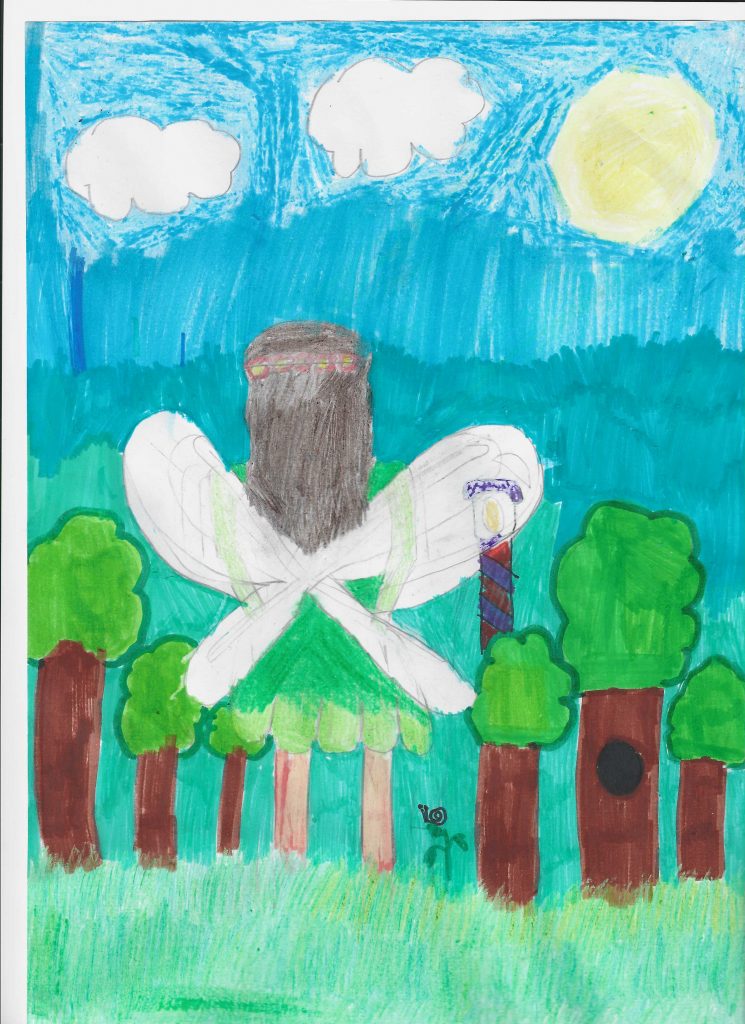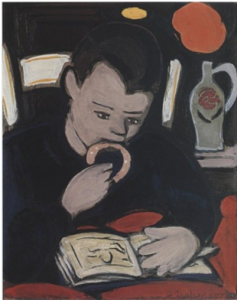Ταξιδεύοντας στην Ελλάδα Συνεργατική εφημερίδα (ελληνική, αγγλική, γαλλική και γερμανική έκδοση) τμήμα Δ1 κ. Μιρέλα Ζωγράφου
ΒΙΤΟΡΙΖΑ
Πίσω από την ιστορία κάθε τόπου κρύβονται πνεύματα και μυθικά πλάσματα που λειτουργούν σαν σύμβολα. Οι θρύλοι αυτοί μεταφέρονται από στόμα σε στόμα και από γενιά σε γενιά και τους μαθαίνουμε κι εμείς οι μικρότεροι.
Ένας μύθος που είναι συνδεδεμένος με την Ερμιόνη (ένα χωριό στο νομό Αργολίδας, στην Πελοπόννησο) είναι εκείνος της Βιτόριζας. Οι παραλλαγές του μύθου είναι πολλές. Μία πρώτη εκδοχή του λέει πως η Βιτόριζα, Βιτομάρτη ή αλλιώς Δίχτυνα, ήταν κόρη του Δία και της νύμφης Κάρμη. Η γλυκιά αυτή γυναίκα απολάμβανε να ψαρεύει, να κυνηγάει και να περιπλανιέται σε δάση και σπηλιές, καθώς ακολουθούσε τη θεά Άρτεμη. Την αγάπησε τόσο πολύ ο Μίνωας, ο βασιλιάς της Κρήτης και ήθελε να την πάρει για γυναίκα του. Αυτή όμως για να γλιτώσει, έπεσε στη θάλασσα. Τότε, μπλέχτηκε στα δίχτυα Ερμιονιτών ψαράδων, οι οποίοι μαγεμένοι από την ομορφιά της, της υποσχέθηκαν να την πάνε στην Αθήνα. Στον δρόμο όμως, έξω από το νησί της Αίγινας, της επιτέθηκαν και αυτή για να σωθεί και από αυτούς. έπεσε στην θάλασσα και ανέβηκε σε ένα δάσος στην Αίγινα, όπου κρύφτηκε για πάντα. Έτσι, οι κάτοικοι την θεοποίησαν και την ονόμασαν Αφαία, δηλαδή άφαντη.
Μία δεύτερη εκδοχή λέει ότι η Βιτώ, όπως ονομαζόταν και αλλιώς η Βιτόριζα, ποτέ δεν ξέχασε την άσχημη συμπεριφορά που είχαν απέναντί της οι Ερμιονίτες ψαράδες και στοίχειωσε το μέρος μας για να τους εκδικηθεί. Έτσι, μερικούς αιώνες αργότερα παρουσιάζεται σαν μία ψηλή, ξερακιανή γυναίκα σαν κακιά μάγισσα. Οι κάτοικοι της Ερμιόνης, κυρίως οι μητέρες και τα παιδιά φοβόντουσαν μήπως τους παγιδέψει στην σπηλιά της στο πευκόφυτο δάσος της περιοχής, στο Μπίστι και τους μαρμαρώσει. Ακόμη ήταν ο φόβος και ο τρόμος των ψαράδων, γιατί τάραζε τα κύματα και προκαλούσε τρικυμίες.
Όποια και να είναι η εκδοχή που θέλει κανείς να κρατήσει σίγουρα η Βιτόριζα αποτελεί ένα αναπόσπαστο κομμάτι της μυθολογίας της Ερμιόνης. Βιβλία, πίνακες ζωγραφικής και γλυπτά κατασκευάστηκαν με έμπνευση αυτή τη μυθική μορφή.
Οι μαθητές που πήραν μέρος ήταν οι: Γιδοπούλου Κωνσταντίνα, Γούτος Αριστοτέλης, Δημαράκη Γιωργία, Δημαράκη Παναγιώτα, Δημαράκης Ανδρέας, Δημαράκης Στέλιος, Ζάρρα Μυρτώ, Ζιαρδαλής Γιάννης, Καζάκης Γιάννης, Κοντογιάννη Σταματίνα, Μίνγκα Έλιο, Μπούτσης Γιώργος, Παλυβός Βαγγέλης. Σοφικίτης Άγγελος.
Οι μικροί μας ζωγράφοι ήταν: Γιδοπούλου Κωνσταντίνα, Δημαράκη Παναγιώτα, Ζάρρα Μυρτώ, Ζιαρδαλής Γιάννης, Κοντογιάννη Σταματίνα και Παλυβός Βαγγέλης.
Βιβλιογραφικές πηγές:
Σπετσιώτης, Γ. & Ντεστάκου, Τζ. (Μάρτιος, 2014). Γυναικεία στοιχειά στους μύθους και τις παραδόσεις της Ερμιόνης από https://orangespotters.blogspot.com/2014/03/blog-post_774.html
Σπετσιώτης, Γ. & Ντεστάκου, Τζ. (Νοέμβριος, 2016). Βιτομάρτη και Βιτόρα: η νύμφη και το στοιχειό από https://mouseioermionis.com/2016/11/19/2
Οι μαθητές του Δ1 τμήματος της Ερμιόνης
και η δασκάλα τους, Μιρέλα Ζωγράφου

VITORIZA
Behind the history of each place there are spirits and mythical creatures that act as symbols. These legends are passed down from generation to generation and the youngest learn them, too.
A myth associated with Ermioni (a greek village in Peloponnese, in Greece) is that of Vitoriza. There are many variations of the myth. A first version says that Vitoriza, Vitomarti, or Dichtina, was the daughter of Zeus and the nymph Karmis. This cute woman enjoyed fishing, hunting and wandering in forests and caves, as she followed the goddess Artemis, the goddess of hunting. Minos, the king of Crete, loved her so much that he wanted to take her as his wife. But she didn’t want him and she fell into the sea to escape. Then, she became entangled in the nets of some fishermen of Ermioni, who were enchanted by her beauty and they promised to take her to Athens. However, on the way outside of the island of Aegina, they were attacked to her, so she fell into the sea and climbed into a forest in Aegina to protect herself, where she hid herself forever. Thus, inhabitants of this island deified her and called her Afaia, that means invisible.
A second version says that Vito, as Vitoriza was also called, never forgot the bad behavior that fishermen of Ermioni had towards her and she haunted our place to take revenge on them. So, a few centuries later she appeared as a tall, very thin woman like an evil witch. Inhabitants of Ermioni, especially mothers and children, were afraid that she would trap them in her cave in the pine forest of the area, in Bisti to pulverize them. She was also the fear and terror of fishermen, because she stirred the waves and caused storms.
Whichever version one wants to keep about Vitoriza, she is certainly an important part of Ermioni’s mythology. Writers, painters and sculptors were inspired by this mythical figure.
The students who took part were: Yidopoulou Konstantina, Goutos Aristotelis, Dimaraki Giorgia, Dimaraki Panagiota, Dimarakis Andreas, Dimarakis Stelios, Zarra Myrto, Ziardalis Yiannis, Kazakis Yiannis, Kontogianni Stamatina, Minga Elio, Boutsis Giorgos, Palyvos Vagelis. Sofikitis Angelos.
Our young painters were: Yidopoulou Konstantina, Dimaraki Panagiota, Zarra Myrto, Ziardalis Yiannis, Kontogianni Stamatina and Palyvos Vagelis.
References:
Spetsiotis, G. & Destakou, J. (March, 2014). Female spirits in Ermioni’s myths and traditions from https://orangespotters.blogspot.com/2014/03/blog-post_774.html
Spetsiotis, G. & Destakou, J. (November, 2016). Vitomarti and Vitora: the nymph and the spirit from https://mouseioermionis.com/2016/11/19/2
The students of Class D of Ermioni
and their teacher, Mirela Zografou
(translation from Mirela Zografou)

BITORIZA
Derrière l’ histoire de chaque lieu se cachent des esprits et des créatures mythiques, qui agissent comme des symboles. Ces légendes se transmettent oralement de génération en génération et arrivent jusqu’à nous.
Une légende, celle de Bitoriza, est associée à Ermioni, un village d’ Argolide dans le Peloponnese en Grèce. L’ une, parmi ces variantes, raconte que Bitoriza, Bitomarti alias Dixtina, était la fille de Zeus et de la nymphe, Karmi. Cette femme douce appréciait la pêche, la chasse et les flâneries dans les forêts et les grottes, alors qu’ elle suivait la déesse Artemis. Minoas, le roi de Crête, était tombé éperdument amoureux d’elle à tel point qu’ il voulait se marier avec elle. Mais, Bitoriza pour s’ échapper est tombée dans la mer. À ce moment-là, elle s’est emmêlés dans les filets des pêcheurs d’ Ermioni. Ceux- ci, enchantés par sa beauté lui ont promis de l’ accompagnée à Athènes. Mais sur le trajet, au large de l’ île d’ Egine, ils l’ ont attaquée et pour se sauver elle est tombée dans la mer, avant de monter sur une forêt à Egine afin de se cacher pour toujours. Ainsi, les habitants l’ont deifiée et l’ont appelée Aphaia, c’est-à-dire invisible-disparuée.
La deuxième variante raconte que Bito, autre nom de Bitoriza, n’ a jamais oublié le mauvais comportement des pêcheurs d’ Ermioni envers elle et pour cette raison, elle a hanté notre village pour se vanger. Alors, quelques siècles plus tard, elle se présente comme une mauvaise sorcière, grande et mince. Les habitants d’ Ermioni, principalement les femmes et les enfants, avaient peur qu’ elle ne les enfermé dans sa grotte, située dans la forêt de pins de la région à Bisti et les petrifient. Les pêcheurs appréhendaient ses humeurs, parce qu’ elle était capable de remuer la mer et de provoquer des tempêtes.
Qu’ elle qu’ elle soit la variante retenue, ce qui est sûr, c’ est que Bitoriza représente un élément indissociable de la mythologie d’ Ermioni. Des livres, des tableaux ainsi que des sculptures se sont inspiré de cette figure mythique.
Les étudiants qui ont participé étaient : Yidopoulou Konstantina, Goutos Aristotelis, Dimaraki Giorgia, Dimaraki Panagiota, Dimarakis Andreas, Dimarakis Stelios, Zarra Myrto, Ziardalis Yiannis, Kazakis Yiannis, Kontogianni Stamatina, Minga Elio, Boutsis Giorgos, Palyvos Vagelis. Sofikitis Angelos.
Nos jeunes peintres étaient : Yidopoulou Konstantina, Dimaraki Panagiota, Zarra Myrto, Ziardalis Yiannis, Kontogianni Stamatina et Palyvos Vagelis.
Références bibliographiques:
Spetsiotis, G. & Destakou, J. (Mars 2014). Éléments féminins dans les mythes et traditions d’Hermione de https://orangespotters.blogspot.com/2014/03/blog-post_774.html
Spetsiotis, G. & Destakou, J. (Novembre 2016). Vitomarti et Vitora: la nymphe et l’ élément de https://mouseioermionis.com/2016/11/19/2
Les élèves de la classe D1 de l’ école primaire d’ Ermioni
et leur maîtresse Mirela Zographou
(traduction de Evangelos Pikoulas)

VITORIZA
Hinter der Geschichte eines jeden Ortes verbergen sich Geister und Fabelwesen, die als Symbole dienen. Diese Legenden werden mündlich überliefertund von Generation zu Generation weitergegeben, und wir, die Jüngeren, lernen sie.
Eine Legende, die mit Ermioni verbunden ist (ein Dorf in der Präfektur Argolis auf dem Peloponnes in Griechenland) ist die von Vitoriza. Die Variationendes Mythos sind zahlreich. Eine erste Version besagt, dass Vitoriza, Vitomarti, oder anders, Dichtyna, die Tochter von Zeus und der Nymphe Carmi war. Diese süße Fraufischte gerne, jagte und wanderte durch Wälder und Höhlen, wenn sie der Göttin Artemis folgte. Sie wurde von Minos, dem könig von Kreta, so geliebt, dass er sie zur Frau nehmen wollte. Doch um zu entkommen, stürzte sie ins Meer. Dann verfing sie sich in den Netzen der Εrmionitischen fischerihr, die von ihrer Schönheit bezaubert waren und versprachen, sie nach Athen zu bringen. Aber auf dem Weg nach Ägina, griffen sie sie an. Um sich zu retten, stürzte sie ins Meer und kletterte in einen Wald auf Aegina, wo sie sich für immer versteckte. Die Einwohner vergötterten sie und nannten sie Aphaia, das heißt, unsichtbar.
Eine zweite Version besagt, dass Vito, wie Vitoriza auch genannt wurde, das schlechte Verhalten der Ermionitischen fischerihr gegenüber nie vergessen hatund unseren Ort heimsuchte, um sich an ihnen zu rächen. So wird sie, einige Jahrhunderte später, als große, dürre Frau, wie eine böse Hexe dargestellt. Die Einwohner von Ermione, insbesondere die Mütter und Kinder, hatten Angst, dass sie sie in ihrer Höhle im Kiefernwald der Gegend, in Bisti, fängt und versteinert. Außerdem war sie die Angst und der Schrecken der Fischer, da sie die Wellen hoch gehen ließ und Stürme verursachte.
Welche Version der Geschichte man auch immer annehmen möchte, ist Vittoriza sicherlichein integraler Bestandteil der Mythologie von Ermione. Bücher, Gemälde und Skulpturen wurden mit dieser mythischen Figur als Inspiration geschaffen.
Die teilnehmenden Schüler waren: Yidopoulou Konstantina, Goutos Aristotelis, Dimaraki Giorgia, Dimaraki Panagiota, Dimarakis Andreas, Dimarakis Stelios, Zarra Myrto, Ziardalis Yiannis, Kazakis Yiannis, Kontogianni Stamatina, Minga Elio, Boutsis Giorgos, Palyvos Vagelis. Sofikitis Angelos.
Unsere jungen Maler waren: Yidopoulou Konstantina, Dimaraki Panagiota, Zarra Myrto, Ziardalis Yiannis , Kontogianni Stamatina und Palyvos Vagelis.
Bibliographische Quellen:
Spetsiotis, C. &Destakou, J. (März, 2014).Weibliche Geister in denMythen und Überlieferungen von Ermione aus https://orangespotters.blogspot.com/2014/03/blog-post_774.html
Spetsiotis, C. &Destakou, J. (November, 2016).Vitomarti und Vitora: die Nymphe und der Geistaus aus https://mouseioermionis.com/2016/11/19/2
Die Schüler der Klasse 4a von Hermione
und ihre Lehrerin, Mirela Zografou
(Übersetzung aus Diana Tsouknida)















